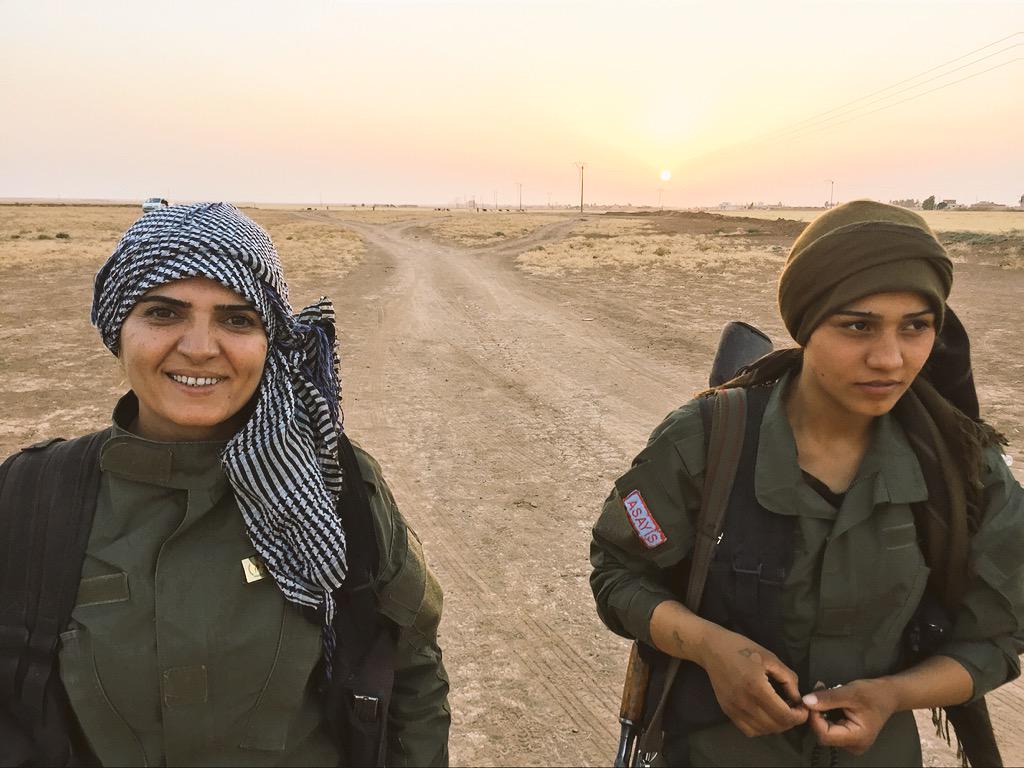
Guerrilla War and Marxist Revolution
The anti-capitalist underdogs who were supported by the people, survived by blending into harsh environments, and who could overthrow entire empires.
"The enemy must not know where I intend to give battle, for it he does not know where I intend to give battle, he must prepare in a great many places. And when he prepares in a great many places, those I have to fight in any one place will be few... And when he prepares everywhere he will be weak everywhere." — Sun Tzu, 500 BCE
"We always know where the soldiers are, but they never know where we are. We can come and go as we like, moving through their lines, but they can never find us unless we wish them to, and then it is only on our terms." — Fidel Castro, 1957
Quotes from: "The War of the Flea," by Robert Taber, 1965.
See the definition of Guerilla Warfare in the M.I.A. Encyclopedia.
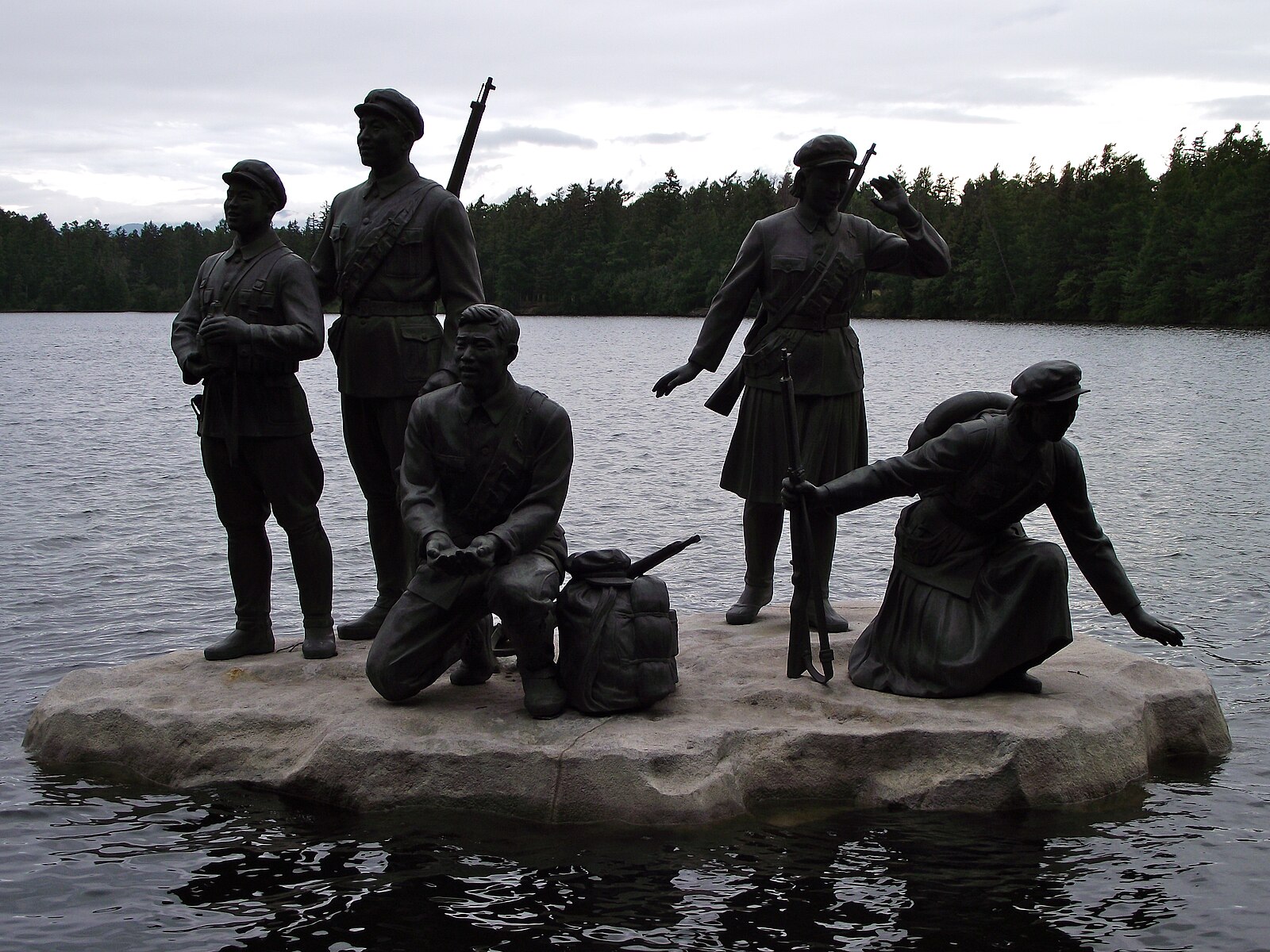
 Table of Contents
Table of Contents
- The Beginning of Socialist Theory about Guerrilla Warfare
- Guerrilla Warfare in the Russian Revolution
- Friends in Hills and Forests: The Socialist Guerrilla Experience in World War 2
- Maoist Contributions to Guerrilla Warfare in China
- Revolution in the Caribbean: The Cuban, Guerrilla Experience
- Socialist Guerrilla Revolutionaries in the Middle East
- Anti-Stalinist and Anti-Maoist Guerrillas Fight
- African Socialist Guerrillas Shake Things Up
- Guerrillas raise the Banner of Socialist Revolution in Asia and Latin America
- Urban Guerrillas Attack the Capitalist System
- Counter-Revolutionary and Conservative Guerrillas: The Bad Apples
- The Future is Anarchist? — Ultra-Leftist Guerrillas in the Modern Era and Their Libertarian Leanings
Guerrilla warfare is the norm. At an age of 200,000 to 300,000 years old, the majority of humanity's conflicts had sticks and rocks as weapons. The soldiers were part-time warriors, drawn away from their communities where they were farmers, hunters, or gatherers for most of the time, supported with food, logistics, and intelligence by their home villages. For 99.9% of humanity's existence, there were no prisons for locking up masses, no torture chambers for extracting confessions, no carpet-bombing or nuclear-powered submarines.
Interstate warfare is the exception.

 The Beginning of Socialist Theory about Guerrilla Warfare
The Beginning of Socialist Theory about Guerrilla Warfare
Guerrillas differ from "regular" soldiers in the following manner:
- Guerrillas are supported by the local peoples, materially and morally.
- Guerrillas make use of the environment in a defensive manner (jungles, forests, mountains, deserts, etc.).
- Guerrillas are non-professional combatants.
- Guerrillas can survive privation. If they cannot, they will fail to be guerrillas.
Ancient China
- Art of War, Sun Tzu, ~500 BCE
Marx and Engels
- Guerilla Warfare in Spain, 1809, Marx 1854
- The Indian Revolt, Marx September 16, 1857
- Engels' Military Writings, 1850-1887.
- Letters on War and Military Science, Marx and Engels 1851-1863.
The Paris Commune
- Instructions for an Armed Insurrection, Auguste Blanqui 1866
Modern, Marxist Theory on Guerrillas
- The Guerrilla, Daniel De Leon, Daily People, December, 1900
- Observations on the Guerrillas, Grandizo Munis, Fourth International, March 1944
- Soldiers, Tony Young, International Socialism, Spring 1965
- Latin America: The People Fight Ahead, Fen Hsi, Peking Review, Vol. IX, #5, Jan. 28, 1966, pp. 15-17
- The African Communist: Latin America and the Ideas of Regis Debray, 1968
- Survey -- The Guerillas: Old and New, International Socialism, April/May 1970
- International Information Bulletin, No. 3 - In Defense of the Leninist Strategy of Party Building, Joseph Hansen, April 1971
- Guerrilla warfare and working class struggle, Theoretical journal of the Leninist-Trotskyist Tendency, 1996
- Less than they bargained for, Chris Harman, October 1999
- The Underdog Comes Out on Top, Raymond Challinor, December 1999
- Iraq: I Wrote Bush’s War Words—in 1965, Daniel Ellsberg, July/August 2005, Vol 5, No. 6
- A Record of Resistance, Dianne Feeley, March–April 2006
Marxist Anti-Guerrillas
- Letter from Hugo Blanco to Joseph Hanson ("Against the Guerrillerista current"), El Frontón, January, 1970
- Guerilla warfare – no alternative to mass struggle, Peter Hadden, November 1983
 Guerrilla Warfare in the Russian Revolution
Guerrilla Warfare in the Russian Revolution

Lenin
- Guerilla Warfare in Russia, Lenin, 1906
- Chapter 2, Lenin, 1906
- The Question of Guerilla Warfare, Lenin, 1906
- Fighting Guerrilla Operations, Lenin, 1906
- The Events of the Day: “Bloody Day” in Warsaw and other towns of Poland, Lenin, Proletary, No. 1, August 21, 1906
Trotsky's Military Writings
"To the question about whether we need guerrillas we must answer: yes, we do need guerrillas, they are necessary for our purpose – but only real guerrillas, really brave men, warriors without fear and without reproach, for whom nothing is impossible." — Leon Trotsky, 1919
From Volume 2 of Leon Trotsky's Military Writings (1919):
- Guerrilla-ism and the Regular Army
- The Southern Front I. The Red Army’s Offensive: Towards the Ukraine and the Don (January-May 15, 1919) - Lessons From The Ukraine
- The Southern Front II. Denikin’s Offensive (May 15-August 1919): The Causes Of The Defeats On The Southern Front
- The Southern Front II. Denikin’s Offensive (May 15-August 1919) - Criminal Demagogy
- How the Revolution Armed The Southern Front, II. Denikin’s Offensive (May 15-August 1919)
- Do We Need Guerrillas?
- ORDER No.180, By the Chairman of the Revolutionary War Council of the Republic and People’s Commissar for Military and Naval Affairs on measures for overcoming guerrilla-ism, December 11, 1919, No.180, Moscow
Red Army History
- The Birth Of The Red Army, Erich Wollenberg, 1937
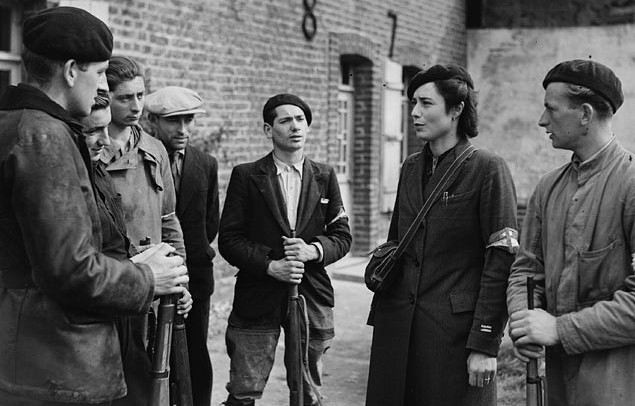
 Shamrocks and Sabotage: The Guerrilla Warfare Legacy in Ireland
Shamrocks and Sabotage: The Guerrilla Warfare Legacy in Ireland
- The Test of Ireland: Part 1, Gerry Foley, from The Test of Ireland, August 1973
- The Test of Ireland: Part 2, Gerry Foley, from The Test of Ireland, August 1973
- The Test of Ireland: Part 3, Gerry Foley, from The Test of Ireland, August 1973
- The Test of Ireland: Part 4, Gerry Foley, from The Test of Ireland, August 1973
- Ireland: Anti-violence Campaign no Solution?, Australasian Spartacist, October, 1976
- Ireland after the Ceasefire, Ted Grant, 1994
- The H-Block Struggle, Brad Duncan, May/June 2013
- Trotskyists Debate Ireland, Workers Liberty, October, 2014
- The Politics of Sinn Féin: Rhetoric and Reality, Kieran Allen, November, 2014
- The 1916 Rising: Myth and Reality, Kieran Allen, November, 2015
 Friends in Hills and Forests: The Socialist Guerrilla Experience in World War 2
Friends in Hills and Forests: The Socialist Guerrilla Experience in World War 2
The guerrilla fighter cannot starve his captured prisoners-of-war -- as the guerrilla fighter himself is starving. The guerrilla fighter cannot lock up the masses in mass camps -- the mobile nature of guerrilla fighting prevents any permanent location. The guerrilla fighter cannot launch indiscriminate weapons of destruction against unarmed populations -- they are too poorly armed for that.
- Why U.S. Workers Should Support National Liberation Struggles, J.R. Johnson, August 1944
Socialist, Anti-Fascist Resistance among the French Maquis
- Guerrilla Warfare: Introduction, T. H. Wintringham & Bert ‘Yank’ Levy, 1941
- The Truth About Guerrilla War, T. H. Wintringham, 1941
- The Manouchian Group, The Resistance, 1940-45.
Left-Wing Guerrillas in Spain
- The Struggle of the Spanish People Continues, Dolores Ibarruri, 1948
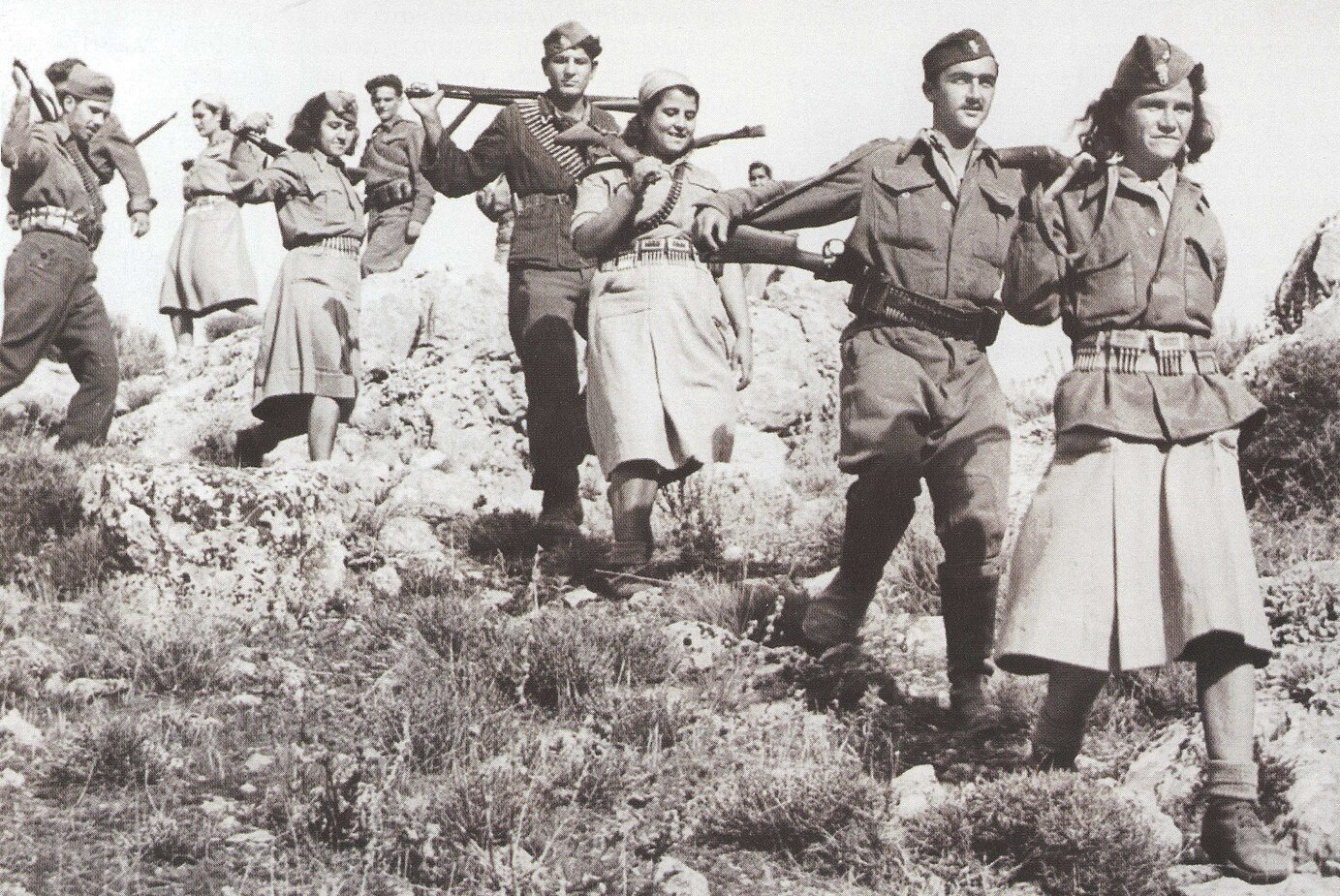
Greek Communist Guerrillas
The Greek Communist guerrillas are a complex story. Greek Communists were famous in resisting Fascism, smuggling food into areas cordoned off by both Axis and Allies, and making notable protests on behalf of food rights of Greeks. But at the end of the war, Churchill and Stalin made a "Percentages Agreement" to guarantee Greece as a non-Communist state, forcing the Greek Communist movement into the brutalities of underground existence. In desperation, the Greek Communists committed human rights atrocities when extracting materials and supplies from local villagers, alienating them from the Greek people. Finally, a spate between Tito in Yugoslavia and Stalin in Russia concluded with the closure of the Greek-Yugoslav border, preventing the Stalin-alligned, Russian-supplied, Greek guerrillas from escaping oncoming state forces, and being utterly annihilated in the final battles. Rarely before in history has such a tiny splinter group interacted with most of the major, political personalities of its time.
- Greek Civil War Index
- Guerilla Army Issues Communique, Bulletin of the American Council for a Democratic Greece, January 1947
- The Guerrilla Struggle in Greece, G.D. from Ergatiki Pali (Workers’ Struggle), 1948
- Peace and Greece - The People Fight Back, Dr. Alex Bebler, 1948
- Tito-Stalin Propaganda War Flares into High as U.S. Grants Aid to Yugos, Hal Draper, 29 August 1949
- Potential Fellow-Draftees!, John F. Petrone, 28 February 1949
- Interview with General Markos Vafiades, former Leader of ELAS, From the Greek Trotskyist paper Socialist Change, 1983
Yugoslavian Guerrillas and Titoist Guerrillas
- The Civil War in Yugoslavia, John G. Wright, April 1943
- Tito and His People, Howard Fast
Soviet Guerrillas Fighting Fascists
- We Are Guerrillas: An Account of the Work of Soviet Partisans behind the Nazi Lines, published by Hutchinson & Co.
The Guerrillas of the Korean Peninsula
- Kim Il Sung Works, 2008
 Maoist Contributions to Guerrilla Warfare in China
Maoist Contributions to Guerrilla Warfare in China
Mao Zedong
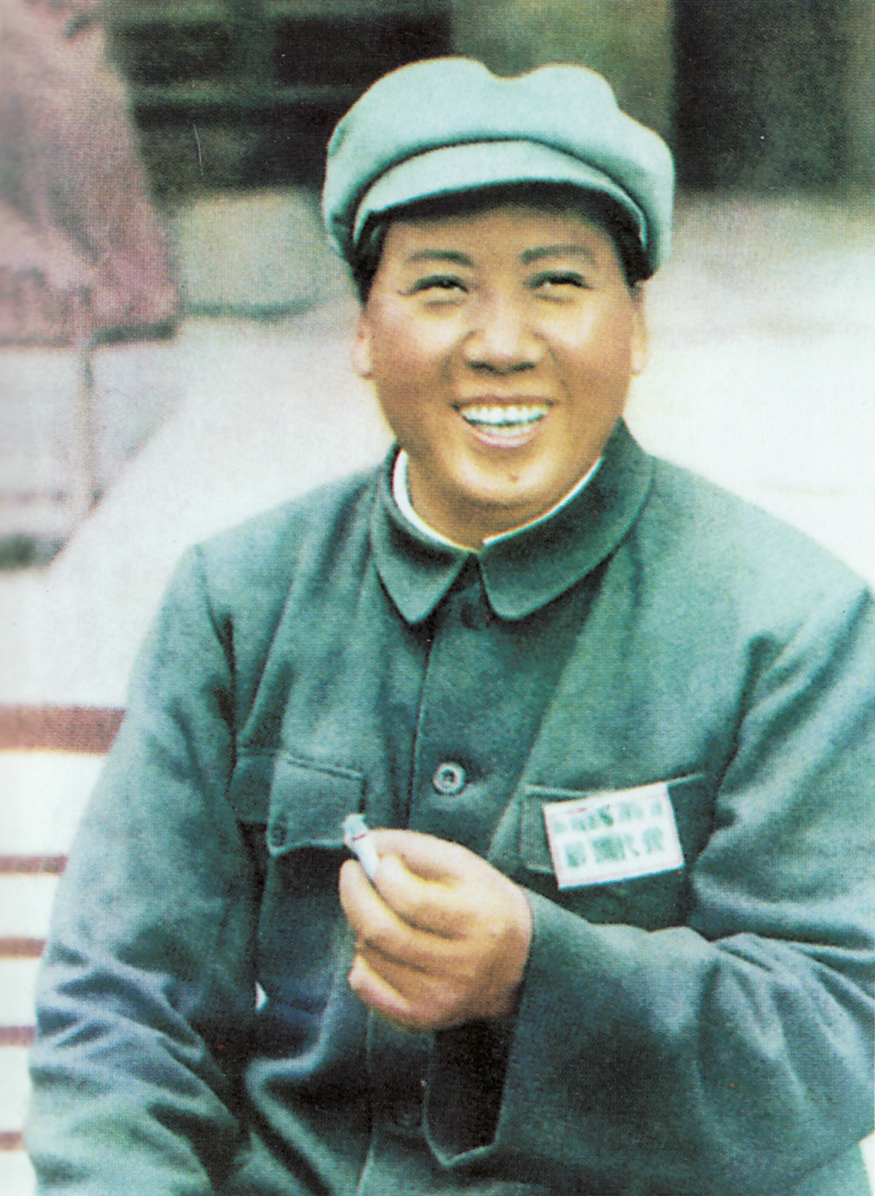
- A Single Spark can Start a Prairie Fire, Mao Zedong, 1930
- On Guerrilla Warfare, Mao Zedong, 1937
- Basic Tactics, Mao Zedong, 1937
- Resisting the Japanese Invasion, Mao Zedong, July, 1937
- Interview with James Bertram , Mao Zedong, October, 1937
- The Situation and Tasks in the Anti-Japanese War, Mao Zedong, November, 1937
- Problems of Strategy in Guerrilla War Against Japan, Mao Zedong, May, 1938
- On Protracted War, Mao Zedong, May, 1938
- The Role of the Chinese Communist Party in the National War, Mao Zedong, October, 1938
- War and Strategy, Mao Zedong, November, 1938
- Production is Also Possible in the Guerrilla Zones, Mao Zedong, January, 1945
- Opinion On The Free Supply System, Mao Zedong, 1960
Chinese Communist Party
- The “Red” Guerilla War in China, Niel-Sih, January 1930
Wang Fanxi (Wang Fan-hsi)
- Guerrilla Warfare: The Lesson of China, Letter from a Chinese Trotskyist, 31 July, 1969
- The Real Lesson of China on Guerrilla Warfare - In Reply to a “Letter from a Chinese Trotskyist”, Ch'en Pi-Lan, January 10, 1971
Lin Biao
- Build a People’s Army of a New Type, Lin Biao, 1965
- Carry out the Strategy and Tactics of People’s War, Lin Biao, 1965
Pao-An
- The Pao-An Guerillas, Wilfred Burchett, 1946
Peng Shuzi
- Return To The Road Of Trotskyism, Peng Shuzi, 1969
 Revolution in the Caribbean: The Cuban, Guerrilla Experience
Revolution in the Caribbean: The Cuban, Guerrilla Experience

The nationalist guerrillas of Fidel Castro and Che Guevara would eventually adopt Marxism after organizing their guerrilla war in the Sierra Maestra mountains in Cuba.
By Che Guevara
- Interview on strategy of Cuban Revolution, Che Guevara, 1959
- Against Bureaucratism, Che Guevara, February, 1963
- Guerrilla warfare: A method, Che Guevara, 1963
- What is a Guerrilla?, Che Guevara, undated
About Che Guevara
- The Final Days of Major Ernesto Che Guevara, Southern Command, Activities of the 2nd Ranger Battalion, 7-9 October 1967
- The double tragedy of Che Guevara, Raya Dunayevskaya, 1967
- Che Guevara, C.L.R. James, Speak Out, November, 1967
- Guevara: Right or Wrong?, Peter Sedgwick, January 1968
Others
- Guerillas in Action, John Corina, 1962
- Revolution Without a Revolution, Regis Debray, 1968
- Criticisms on the U.S. SWP’s Opinion on Cuba, Peng Shuzi, 1982
- 20 Years Ago Che Guevara Was Murdered by the CIA, 1987
- Colombia and Cuba: a Tale of Two Countries, W.T. Whitney, 2018
 Socialist Guerrilla Revolutionaries in the Middle East
Socialist Guerrilla Revolutionaries in the Middle East

Palestine
- U.S. Imperialism, Arch-Criminal in SuppressingPalestinian Guerrilla, Peking Review, No. 31
- U.S. Imperialism Is Chief Wire-Puller in Suppression of Palestinian Guerrillas, Peking Review
- U.S. Imperialism Engineers Large-Scale Armed Suppression of Palestinion Guerrillas in Jordan, Peking Review, No. 39
- Palestine: Guerilla Organisations, Ibraham Ali, 1969
- The Popular Front for the Liberation of Palestine on People’s War, 1969
- U.S. Plots to murder Guerrillas
- The Lebanese and the War, Domingo del Pino, 1974-1975
- The Lebanese and the War, Peking Review, 1975
Iran
Find more about guerrilla movements in Iran at the Guerrilla Movements in Iran.
- Hamid Ashraf Archive
- Documents of the Iranian Revolutionary Movement, Ashraf Dehghani
- Armed Struggle; both a Strategy and a Tactic - Introduction by The Iranian People’s Fadaee Guerrillas, Massoud Ahmad-Zadeh
- In Defense Of Iran, Urgent Tasks - Number 7, an editorial, Winter, 1980
- Fedai Guerrillas Speak on Armed Struggle in Iran, 2017
 Anti-Stalinist and Anti-Maoist Guerrillas Fight
Anti-Stalinist and Anti-Maoist Guerrillas Fight
Anti-Soviet and Anti-Mao Guerrillas
- Guerrilla Opposition Against CP Makes News in Rumania and China, Labor Action, 1 August 1949
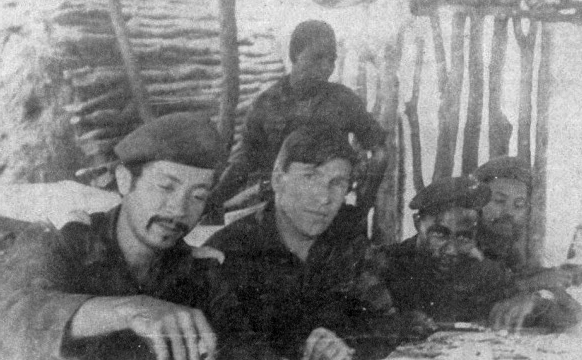
 African Socialist Guerrillas Shake Things Up
African Socialist Guerrillas Shake Things Up
Angola and Namibia
- Revolution and Reconstruction, Jonas Savimbi, 1967
- Angolan Guerrillas Fail to Heal Rift, World Outlook, 1967?
- A Message to Companions in the Struggle, Agostinho Neto, June, 1968
- People's War in Angola, Roy Harvey, September, 1968
- With the Guerrillas of Angola, Don Barnett, 1970
- Spartacus Monimambu, LSM Information Center, June, 1970
- With the "Black Chinese" in Angola, National Union for the Total Independence of Angola, 5/10/1971
- Angola MPLA: Interviews in Depth, Interview with Seta Likambuila, 1974
- Treacherous Crossing: Namibian Independence Debacle, Southern Africa Report, July, 1989
Eritrea
- Eritrea: Past and Present, De Wen
- Eritrean Guerrillas, Round the World
- Eritrea: The Hidden War in East Africa
- Equality to Die For?: Women Guerrilla Fighters and Eritrea's Cultural Revolution, Victoria Bernal, 2000
Kenya (Mau Mau)
- The Urban Guerrilla, by Mohamed Mathu, 1974
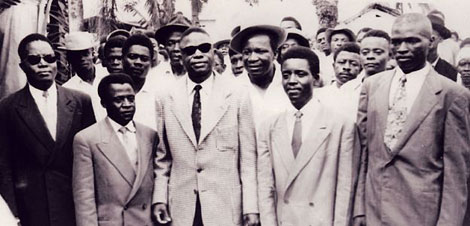
Cameroon
From Wikipedia: The Cameroon War (also known as the Hidden War, or the Cameroonian War of Independence) is the name of the independence struggle between Cameroon's nationalist movement and France. The movement was spearheaded by the Cameroonian Peoples Union (UPC). Even after independence, the rebellion continued, shaping contemporary politics. The war began with riots in 1955 and continued after Cameroon gained independence in 1960. Following independence, the first President of Cameroon, Ahmadou Ahidjo requested continued French military intervention to fight the UPC rebels. The UPC rebellion was largely crushed by the Cameroonian Armed Forces and French Army by 1964.
- The Cameroon Guerrilla Movement, Guerrilla Fronts
Zaire (Democratic Republic of Congo)
- Speaking Out on Zaire, Modern Times, Vol. II, No. 7, July 1978
Western Sahara
- Western Sahara: A War That's Nearing the End, Manuel Somoza
Mozambique
- Memorandum Submitted to the 8th Session of the Eleven Nation African Liberation Committee -- Dar Es Salaam, Mozambique Revolutionary Committee, 31st, January, 1966
- The Valliant Hero, Official Organ of Coremo, April, 1966
- Two Years of Armed Struggle in Mozambique, Peking Review, Aug/Sep, 1968
- Mozambique People’s Armed Forces Grow in Strength, Peking Review, 1968
- CFM News & Notes, Committee For a Free Mozambique, 1972
- A Message to the People, From the Central Committee to the Mozambican People
- Mozambican Revolution:
- Mozambican Revolution, No 23, Mozambique Liberation Front, January & February, 1966
- Mozambican Revolution, No 24, Mozambique Liberation Front, May, 1966
- Mozambican Revolution, No 25, Mozambique Liberation Front, June/July, 1966
- Mozambican Revolution, No 28, Mozambique Liberation Front, May, 1967
- Mozambican Revolution, No 29, Mozambique Liberation Front, June/July, 1967

Guinea & Cape Verde
- The African Party for the Independence of Guinea and Cape Verde (PAIGC) Archive
- Determined to Resist: Guerrilla Struggle in Guinea-Bissau, Amilcar Cabral, Tricontinental, No. 8, 1968
- With the Guerrillas in “Portuguese” Guinea, Gérard Chaliand, Introduction by Basil Davidson, 1969
- Chronology of events in Portugal 1974-75, Portugal — Revolutionary Developments April 1974-Dec. 1975 [Sam Marcy]
- The Banta Promise
Zimbabwe
- Zimbabwe: Guerrilla Struggle
- Zimbabwe: Confronting the White Minority
- A Smuggled Account from a Guerrilla Fighter, Africa Research Group, 1969
- Zimbabwe People's Army, ZIPA, 1976
- Zimbabwe: Total War, Executive Secretariat Of Ospaaal
- Zimbabwe: The Time for Negotiations is Over
South Africa
- Prospects for Armed Struggle in South Africa, Joe Slovo, 1968
- Southern Africa: A Monthly Survey of News and Opinion, Vol 3, No. 1, January, 1970
 Guerrillas raise the Banner of Socialist Revolution in Asia and Latin America
Guerrillas raise the Banner of Socialist Revolution in Asia and Latin America
_insurgents.gif)
India (Naxalites)
- A Few Words About Guerrilla Actions, Charu Mazumdar
- Communist Party of India (M-L) Leads Indian People Onward Along Victorious Path of Seizing Power By Armed Force
- Peasants' Armed Struggle led by Communist Party of India (M-L) Develops Steadily, Peking Review
- India People's Armed Forces Are Growing Stronger in Battle, Peking Review, August 6, 1969
- Indian Monthly "Liberation" Sums Up Experiences of Armed Peasant Struggle In Mushahari, Peking Review, January 30, 1970
- Indian Peasant Armed Struggle Intensifies, Peking Review, No. 7
- India's Revolutionary Armed Struggle Surges Forward, Peking Review, No. 44
Bengal
- Rely upon peasants in National Liberation War!, Siraj Sikder, October 1971
Philippines
- The Philippine Guerillas, Wilfred Burchett, 1946
- Roxas Regime Launches War on “Huk” Guerrilla Fighters, Larissa Reed, 1946
- New Philippine Government Uses Mailed Fist on Huks, Dave Dreiser, 16 August 1946
- A Semi-feudal Alibi for Protracted War, Filemon Lagman, 1994
- A New-Type Revolution of the Wrong Type, Lagman, 1994
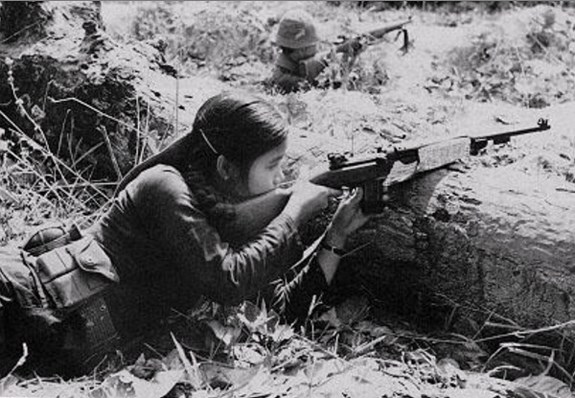
Vietnam
For many readers here, the Vietnam War may be the first situation in which they heard about guerrilla warfare, as it was a war which popularized this tactic. But here, like many other places, we have a complicated situation. The French conquered Vietnam, at the behest of a religious missionary, in the middle of the 1800's. Resistance was almost immediate. When the United States "took over" for the French Foreign Legion, they did so for the exact same reason as the French: to maintain their empire. Every year of the Vietnamese War, the Communists and Ho Chi Minh offered to end the war immediately -- as long as there were democratic elections, which the US kept refusing. But the Vietnamese Communists weren't saints, either: there were some token suppression and executions of Trotskyists to appease Moscow and there were executions of the leaders of hostile, religious orders to consolidate power.
- Kennedy’s War in Vietnam, International Socialist Review, Summer 1963
- United Secretariat of the Fourth International: Hands Off the Vietnamese Revolution, International Socialist Review, Spring 1965
- Letters to the South, by Le Duan, 1965
- The great battle to liberate Phnom Penh, The Call, Vol. 7, No. 22, June 5, 1978
- Biography of Ho Chi Minh, from Selected Works
- The Strategic Role Of The Self-Defense Militia Force In The Great Anti-U.S. National Salvation Struggle Of Our People, Võ Nguyên Giáp, 1967
Cambodia
Cambodia is an interesting yet tragic situation. One cannot tell the story of Cambodia without telling the story of Vietnam. Geographically, Vietnam has traditionally been called a bamboo pole holding two bags of rice on each end -- it is two massive, grain-growing regions connected by a very thin valley that allowed culture (and armies) to ebb and flow between the two for thousands of years. Along this whole western frontier of Vietnam, one has Cambodia. During the Vietnam War, Vietnamese socialists used Cambodia as a corridor for logistics and supplies to South Vietnamese guerrillas; this gave importance to the Cambodian Communist Party. Eventually, Pol Pot, a leading Cambodian Communist aided and helped by the CIA, seized power and control over the party, purging it of any and all moderating, Vietnamese influence. A famous film about Pol Pot's rule is called The Killing Fields, a depiction of Pol Pot's Communists (the Khmer Rouge) and their mass genocide of one third of the country. The Vietnamese Army invaded Cambodia, against all international opinion (Soviet and US), and abolished the rule and policy of the Khmer Rouge. To the surprise of international observers, Vietnamese Communists restored the previous popular policies of Cambodia, including those oriented in favor of the market and (so-called "Capitalist") private property. The Vietnamese Communist Party intervening against the Cambodian Communist Party was one of the most important human rights interventions of the century, and one that has been derided and abused by both the Left and the Right.
- Kampuchea: UNITY report from behind the lines, Richard Fleming and Elizabeth Erlich, Unity, Vol. 3, No. 15, August 8-21, 1980
- Pol Pot gives first interview since Vietnamese invasion, The Call, Vol. 8, No. 49-50, December 24, 1979
- Setting the Record Straight on Kampuchea, Daniel Burstein, The Call, Vol. 9, No. 34, October 20-November 2, 1980
- Inside a secret Khmer Rouge base - Special to The Call, 1980
Malaysia
- Malayan National Liberation Army - Persevering in Guerrilla War, Peking Review, 1968
Nicaragua
- The Deep Crisis of Sandinismo, Vilma Núnez de Escorcia, July–August 2000
- Nicaragua Twenty-five Years Later, Dianne Feeley, 2004
Guatemala
- Otto Rene Castillo Archive
- Conquest and Courage, Deborah L. Billings
- Rigoberta Menchú: A Witness Discredited?, Cindy Forster
- Central America After Reaganism, Dianne Feeley
- Letter from the Guerrilla Army of the Poor to the North American People, Guerrilla Army of the Poor (EGP), July, 1982
El Salvador
- The League of Revolutionary Struggle talks about: The Salvadoran struggle and support in the U.S., Unity, Vol. 5, No. 6, April 9-22, 1982
- The FMLN's Historic Victory, Marc Becker, May-June 2009
- Salvadoran Women Combatants, Diana C. Sierra Becerra, Oxford University Press, 2013

 Urban Guerrillas Attack the Capitalist System
Urban Guerrillas Attack the Capitalist System
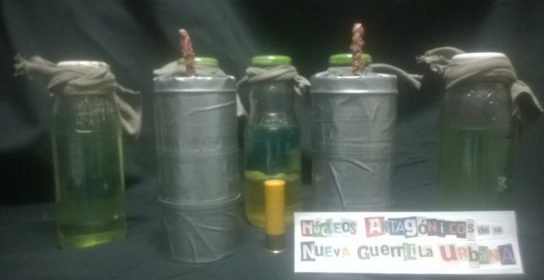
Urban guerrillas are a modern variant of the guerrilla tactic, beginning in the 1960's and 1970's in Latin American countries, but also including some European groups, such as the Baader-Meinhof Gang, a group that collaborated in kidnappings with Palestinian revolutionary groups. These guerrillas, by operating in urban areas, tend to have a higher rate of civilian casualties, which often costs them public support and can lead to their downfall. In a sense, the urban guerrilla is the guerrilla closest to pure, domestic terrorism, but the difference is that the urban guerrillas are organized into deeply-knit, well-entrenched cells that irregularly work together. A terrorist differs from the guerrilla in this way: the guerrilla wants to maximize public support, the terrorist wants to maximize the number of deaths in the struggle. The difference is very clear.
Argentina
- Political Committee Minutes, Statement of Argentina, April 3, 1972
- Resolutions of the Fifth Congress of the Partido Revolucionario de los Trabajadores, [Argentine Section of the Fourth International—Ejército Revolucionario del Pueblo/ Revolutionary Army of the People] 1970-1973—Trotskyist supporters of armed struggle
- The Transitional Program Now, Nahuel Moreno, 1980
- Argentina and Bolivia -- The Balance Sheet, Socialist Workers Party (U.S.) International Internal Discussion Bulletin, January 1973
- Two methods for the Latin American revolution, CEHuS Centro de Estudios Humanos y Sociales, 2016
Brazil
- Mini-manual of the Urban Guerrilla, Carlos Marighella, 1969
Bolivia
- For Bolivia!, Rouge, October, 1969
- The Lessons Of Bolivia, Anibal Lorenzo, 1971
- The Lesson Of Bolivia, Socialist Workers Party (U.S.) International Internal Discussion Bulletin, January, 1973
- Socialist Workers Party (U.S.) International Internal Discussion Bulletin: IV. The Crisis in the Fourth International, Hugo Blanco, Peter Camejo, Joseph Hansen, Anibal Lorenzo, Nahuel Moreno, January, 1973
Venezuela
- The Pierre Goldman Affair, 1969-1979
Uruguay
From Wikipedia: Revolutionary Movement Tupamaro (Spanish: Movimiento Revolucionario Tupamaro, MRT), often shortened to Tupamaro, is a far-left Marxist-Leninist communist party and one of the most prominent colectivos in Venezuela. Several Tupamaros participate in peaceful movements while some believe in the "idea of armed struggle as a means to gain power." The group supports the National Liberation Army (ELN) and allegedly had ties with Revolutionary Armed Forces of Colombia (FARC).
- The Tupamaros: Rise and Fall, Frank Roberts, International Socialism, No.66, February 1974
Colombia
From Wikipedia: The Revolutionary Armed Forces of Colombia – People's Army (Spanish: Fuerzas Armadas Revolucionarias de Colombia – Ejército del Pueblo, FARC–EP or FARC) is a Marxist–Leninist guerrilla group involved in the continuing Colombian conflict starting in 1964.
- U.S. Intervention Threatens Colombia, Proletarian Revolution No. 61 (Summer 2000)
- Colombia: A Dependency Problem, Chris Harman, Socialist Review, No.245, October 2000
- Colombia: Options from the Grassroots, Joanne Rappaport, June 2001
- Latin America and the future of the Farc, Mike Gonzalez, May–June 2002
- U.S. Escalates Colombia’s Dirty War, Tristan Adie, International Socialist Review, May–June 2002
- Colombia: Closing the Circle of Violence, Cecilia Zárate-Laun, November–December 2001
- Colombia From Peace to War Again, Forrest Hylton, May–June 2002
- Colombia: Neoliberalism and Violence, Forrest Hylton, November–December 2002
- Colombian Front for Socialism, Maria Cristina Gutierrez, 2010
- A Partial Peace in Colombia, Kevin Young, 2017
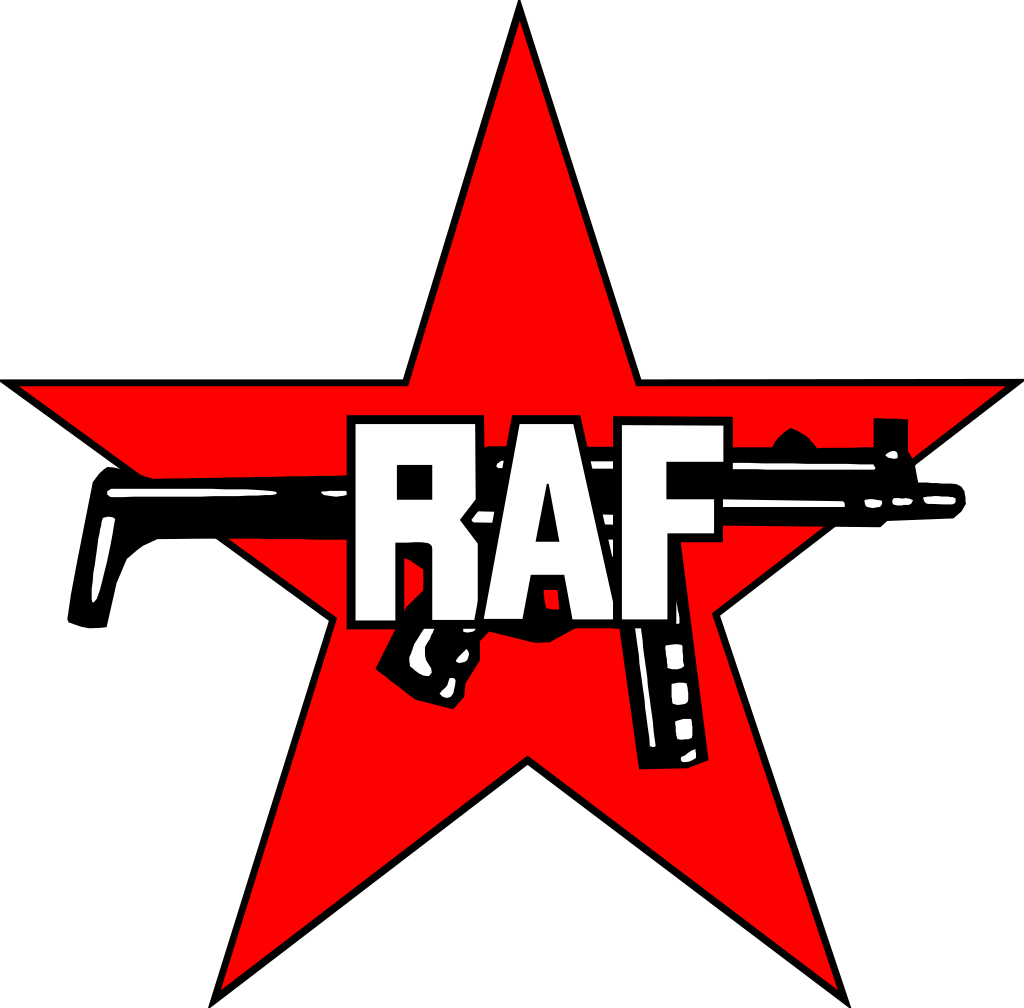
Germany
From Wikipedia: The Red Army Faction (RAF), also known as the Baader–Meinhof Group or Baader–Meinhof Gang, was a West German far-left militant group founded in 1970 and active until 1998. The RAF described itself as a communist and anti-imperialist urban guerrilla group. It was engaged in armed resistance against what it considered a fascist state. Members of the RAF generally used the Marxist–Leninist term "faction" when they wrote in English.
- The Slow Death of Andreas Baader, by Jean-Paul Sartre 1974
Mexico
- Mexico: Insurrection and Disintegration, Dan La Botz
Québec, North America
The Front de Libération du Québec is a socialist, nationalist guerrilla movement active in the liberation of Québec. From Wikipedia: The Front de libération du Québec (FLQ) was a militant Quebec separatist group which aimed to establish an independent and socialist Quebec through violent means. It was considered a terrorist group by the Canadian government. Founded sometime in the early 1960s, the FLQ conducted a number of attacks between 1963 and 1970.
- Front de Libération du Québec Archive, 1963-1971
Algeria
From Wikipedia: The Algerian War (also known as the Algerian Revolution or the Algerian War of Independence) was a major armed conflict between France and the Algerian National Liberation Front (FLN) from 1954 to 1962, which led to Algeria winning its independence from France. An important decolonization war, it was a complex conflict characterized by guerrilla warfare and war crimes. The conflict also became a civil war between the different communities and within the communities. The war took place mainly on the territory of Algeria, with repercussions in metropolitan France.
- History of Algerian Independence
- France and Algeria, Alain Krivine, 1956-1962
Turkey
From Wikipedia: Mahir Çayan (15 March 1946 – 30 March 1972) was a Turkish communist revolutionary and the leader of People's Liberation Party-Front of Turkey (Turkish: Türkiye Halk Kurtuluş Partisi-Cephesi). He was a Marxist–Leninist revolutionary leader. On 30 March 1972, he was killed in an ambush by Turkish Military Forces with nine of the other members of THKP-C and THKO in Kızıldere village.
USA
- Afro-American Guerilla Warfare, A. Weisbord
- The 12-Point Program of RAM, 1964
 Counter-Revolutionary and Conservative Guerrillas: The Bad Apples
Counter-Revolutionary and Conservative Guerrillas: The Bad Apples
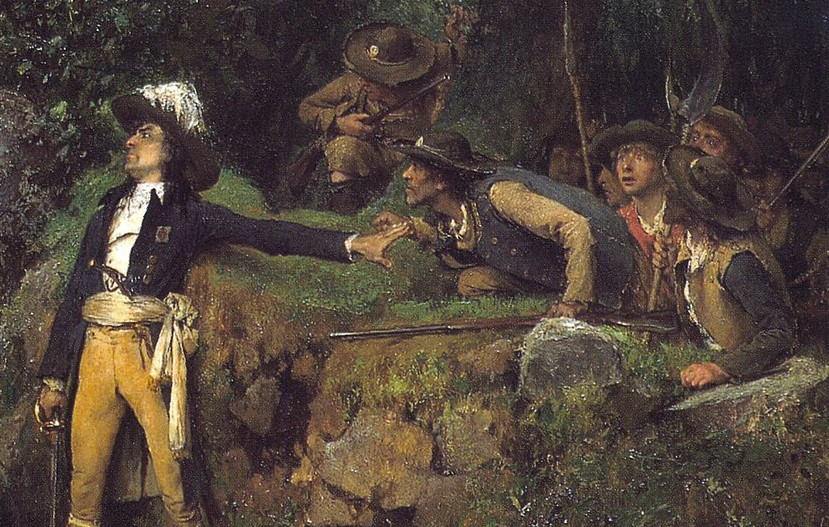
There is generally one kind of good guerrilla: a devoted partisan fighting for social justice and their people. But there is every type of evil guerrilla: extremist religious guerrillas (the Taliban in Afghanistan, the Catholic Vendee in France and Spain, Protestant confederate soldiers in the US South), or state-sponsored guerrillas (anti-Sandinista Guerrillas in Guatemala, anti-Castro guerrillas in Cuban mountains, virtually any type of guerrilla labeled "anti-Communist guerrilla").
One must remember that guerrilla war is a war of privation. It is a war of living off of berries, sleeping under tents, and only getting a shower when you're near a river or when it rains. Professional soldiers simply can't hold up under these conditions -- although governments have obviously coveted this type of military unit and created their own version, "the commando" (or Green Beret). For the overwhelming majority of counterrevolutionary fighters, religion is their ideology; one must have extreme conviction to live as a guerrilla and be willing to spend a lifetime as a guerrilla. Social Revolution obviously fits that mold, but so does extremist, conservative religion.
Iraq
Against a nearly unananimous, global opposition to the war, George W. Bush invaded Iraq. This created the precedent of a massive empire destroying a small, tiny nation with a campaign of lies to justify the war. Without the Iraq War, the Ukraine War would have been impossible. Vladimir Putin's steps are foot-by-foot in line with those of American Imperialism. Today Iraq is a breeding ground for religious fanaticism, such as ISIS; the fake threat of "weapons of mass destruction" has been replaced with the very real danger of extremist Islamism.
- Contradictions of the Iraqi Resistance: Guerilla War vs. Terrorism, Michael Schwartz
- Troops Out of Iraq, Workers Action, April/May 2003
- Iraq Occupation in Disarray, Proletarian Revolution No. 69 (Winter 2004)
- Iraq: Why We Cannot Win, Al Lorentz, 2004
- U.S. Out Now!: Iraq Occupation in Disarray, Proletarian Revolution, Winter, 2004
- Iraq: Guerrilla War in Sadr City, Michael Schwartz, 2005
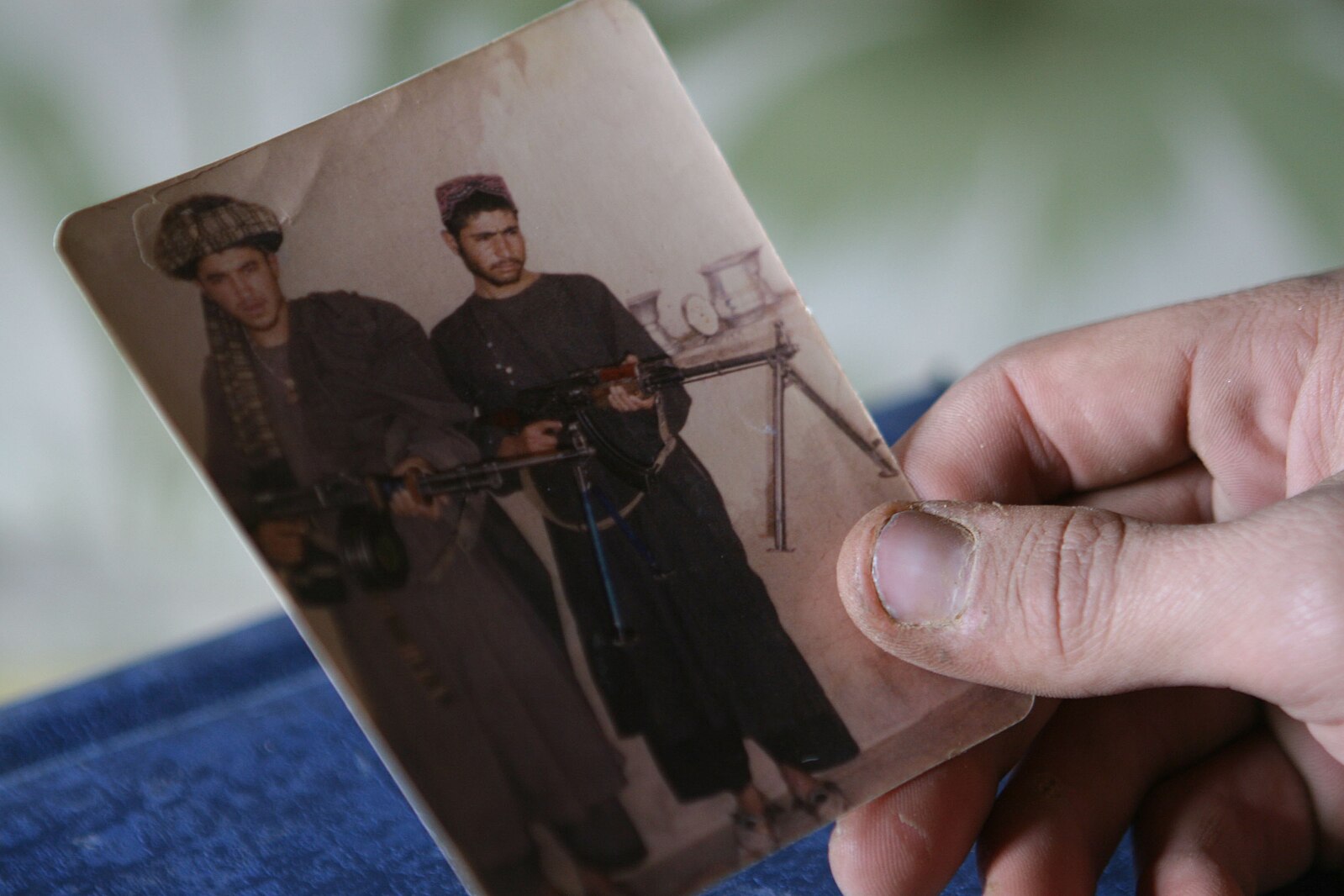
Afghanistan
The case of Afghanistan is difficult. In the 1980's, the United States presidency of Ronald Reagan spent more than $660,000,000 to extremist, Islamic terrorists, including, most famously, Osama bin Laden. This was all to help fight the USSR and Soviet expansionism. The USSR was supporting an urban-based, Communist regime. The problems with this government were numerous: in line with Russian-Marxist thinking, the countryside was ignored and the focus was on the capital and major cities; in addition, the regime was insensitive to local feelings of the masses, to the point of committing some human rights abuses. That being said, Conservative Afghans were polygamous in the tradition of Islam, treating women (whatever age) as their property (for any use, and to be accumulated in any amount), and the homelife of the majority was under extremely brutal, patriarchical rule. Ironically, Pashtuns (indigenous Afghans) have a council-system in their villages that establish a basic, democratic-socialist organization (the jurga, جرګه) of the type typified of Rousseau's "noble savage." Instead of appealing to this indigenous communitarianism, the USSR focused on its modern, Atheistic Communism, completely alienating the locals and driving them into the arms of extremist, radical sheikhs. And these sheikhs had decades of education experience in their madrassas, which gave them credibility in the eyes of their followers.
- Exclusive: Afghan rebels on the march, The Call, Vol. 8, No. 32, August 27, 1979, David Kline
- Popular rebellion weakening Soviet-backed Afghani regime, Unity, Vol. 2, No. 17, August 24-September 6, 1979
- Soviets face peoples’ war in Afghanistan, Unity, Vol. 3, No. 2, January 18-31, 1980
- Who are the Afghan guerrillas?, Unity, Vol. 3, No. 5, February 29-March 13, 1980
- Afghan rebels loosen Soviet grip, David Kline, The Call, Vol. 9, No. 42, November 5, 1980
- Afghanistan: 2 years of occupation, 2 years of resistance, Unity, Vol. 5, No. 2, February 12-25, 1982
- Mujahideen and Dealers, Against the Current, No. 27, July/August 1990
- Congratulations, America: You Have Made Bin Laden A Happy Man, Robert Fisk, February 2002
- Afghanistan Rebels target Soviets
 The Future is Anarchist? — Ultra-Leftist Guerrillas in the Modern Era and Their Libertarian Leanings
The Future is Anarchist? — Ultra-Leftist Guerrillas in the Modern Era and Their Libertarian Leanings
The era of Marxist guerrilla has reached a twilight; and extremist, religious terrorists have been wholly discredited globally, both by their enemies and by their own people. Guerrilla warfare almost saw its own demise. But this ancient tactic was resurrected and brought into meaning once again, with the resurgence of Anarchist guerrilla activity in the late 20th and early 21st centuries. Many of these Anarchist revolutionaries, though, are often influenced by Marxism.
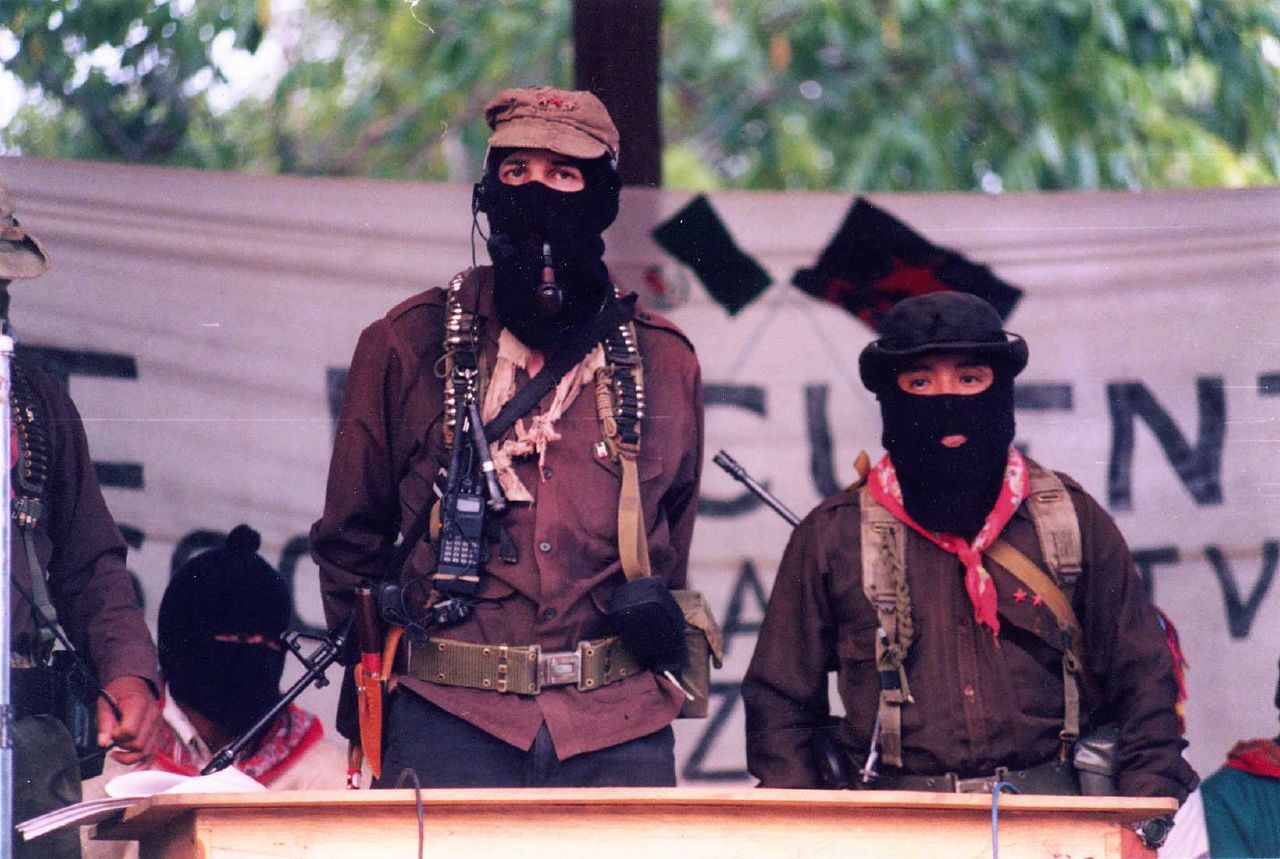
Chiapas
The Zapatistas (officially: The EZLN, Zapatista Army of National Liberation) are the first, well-known group of Anarchist guerrillas in the modern era. This Left-Libertarian group has its base in the Chiapas, Mexico. Their "leader" is known as a "subcomander," with "sub" implying his subordination to the local areas with Anarchist administration. These areas are under control by their own indigenous peoples, the Tzotzil, Tzeltal, Tojolabal, Ch’ol, and many, many others. These guerrillas champion many causes: they fight for workers, environmentalism, LGBT, the indigenous, sex workers, and transgendered peoples. Numerous Zapatista publications and speeches discuss befriending "the other", the ones considered untouchable by society. These guerrillas have controlled their own territory since their uprising in 1994, although they always mention that their struggle is actually 500 years old.
- Zapatista Rebellion Opens Door ot New Stage of Mexican Revolutian, Rosendo Mendoza, In Defense of Marxism, March 1994
- Our Struggle Is for the Land, an interview with Luis, a Zapatista, March/April 1994
- Lessons of the Chiapas Uprising, James Petras and Steve Vieux, January-February 1996
- Mexico after the Zapatista Uprising, Lance Selfa, International Socialism, July 1997
- The Zapatistas: The challenges of revolution in a new millennium, Mike Gonzalez, International Socialism, Winter 2000
- Democracy Against Politics, Joseph Grim Feinberg, September-October 2008
Rojava
Rojava (officially: AANES, Autonomous Administration of North and East Syria) is a new, Anarchist-influenced administration operating in Northern Syria (the areas of Afrin, Jazira, Euphrates, Raqqa, Tabqa, Manbij, and Deir Ez-Zor) since 2012. This is effectively the social and political organization of the ethnic Kurds in the region, whose homeland ("Kurdistan") spans Syria, Turkey, Iraq, and Iran, but have been left out of border drawings done by European powers. In the 1980's and earlier, the Kurdish leftist revolutionaries expressed their yearnings through the PKK (Kurdistan Workers' Party), a Marxist organization, but with the coming of the 1990's, this organization and its various associate groups, have veered more and more in an Anarchist direction.
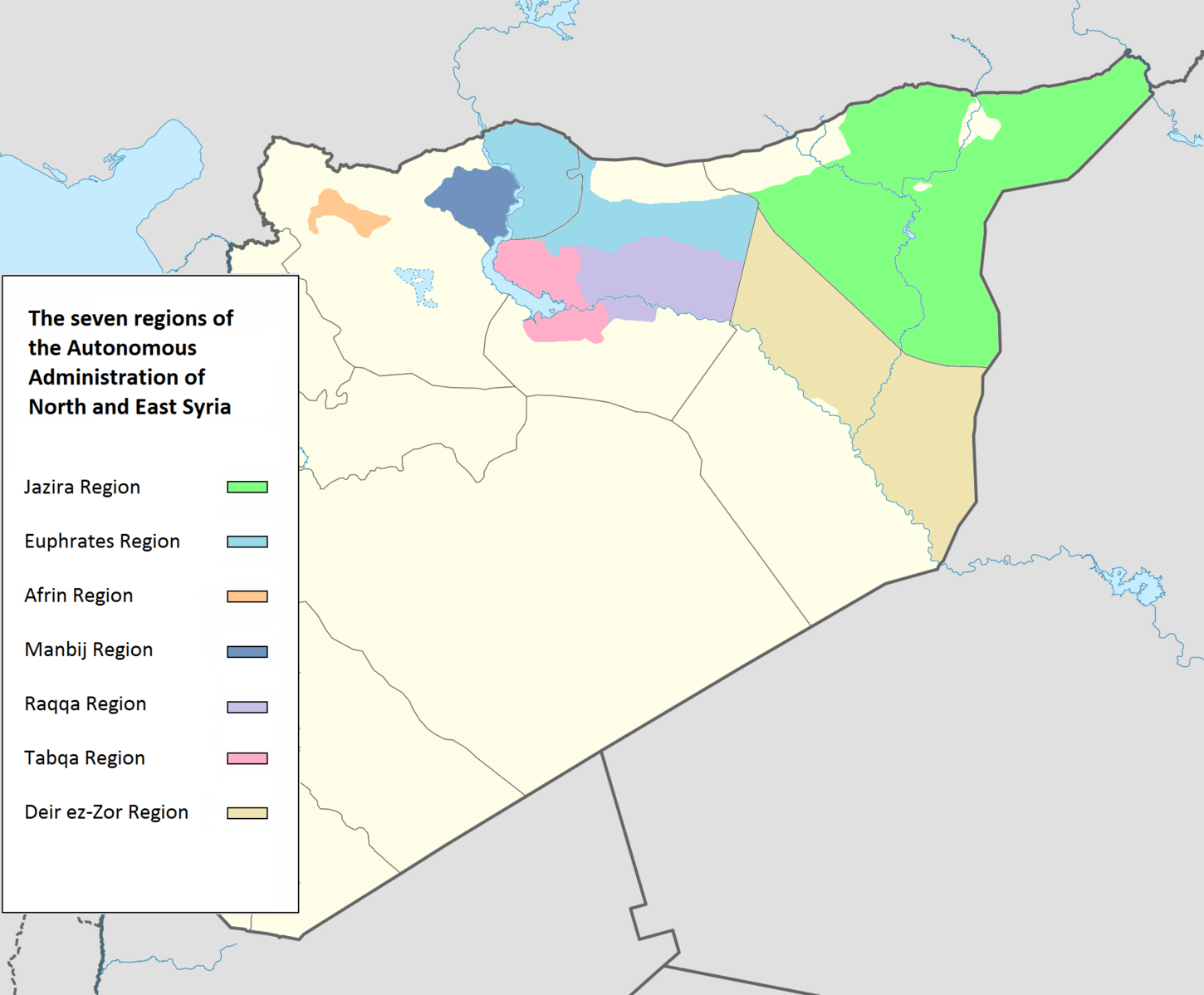
Their philosophy is articulated by the Kurdish revolutionary Abdullah Öcalan, who has been inspired by the New York Anarchist, Murray Bookchin. Öcalan is famous for having been possibly the last person sentenced to death by Turkey (rescinded as a condition of Turkey joining the EU) and being the only person to be imprisoned alone on a fortress island in the Mediterranean. Generally, the Kurds avoid the phrase "anarchism" and tend to use more Bookchinian phrases, like "autonomous" or "municipal." The three pillars of the Rojava Charter (its constitution) are radical democracy, feminism, and environmentalism. Many Kurds are Alevis, a form of Islam strongly influenced by local Kurdish traditions focused on worshipping and protecting nature, rivers, and mountains. (Many practitioners of Islam outside certain extremist, Middle East regions are actually like this, in terms of moderating Islamic strictness with local fairytales.) There is a particular combination of political, social, economic, and even religious factors that partake in making the modern, Kurdish guerrilla fighters.
- Inside the Revolutionary War in Kurdestan, Revolutionary Worker, July 11, 1980
- Public Meeting: Kurdistan, RCG: Fight Racism! Fight Imperialism!, 1991
- Imperialists Set Up Iraqi Suppression of Kurds, Australian Spartacist, May/June, 1991
- The Tragedy of Kurdistan, In Defense of Marxism, June, 1991
- Kurdish Women fight for Freedom - Interview with YJWK, Fight Racism! Fight Imperialism!, February/March, 1992
- Turkish Kurds' fight for autonomy heats up; leadership jockeys for maneuvering room, Socialist Action, April, 1992
- Massacres and Resistance in Kurdistan, Fight Racism! Fight Imperialism!, April/May 1992
- The Workers' Movement in Kurdistan, Workers News, July 1992
- Kurdistan: Revolution at a Critical Juncture, Fight Racism! Fight Imperialism!, August/September 1993
- Kurdistan: Balanced on a knife edge, Socialist Review, February 1994
- Protest Germany's Anti-Kurdish Repression!, Workers Vanguard, April 15, 1994
- Turkish forces invade again, Workers Press, July, 1995
- Get Out of the Gulf!, Workers News, September 13, 1996
- Kurdish Prisoners in British gaols, Fight Racism! Fight Imperialism!, October/November, 1996
- Behind the Events in Iraq and Kurdistan, Tom Barrett, November/December, 1996
- Turkish Regime Invades Iraq, Slaughters Kurds, Workers Vanguard, June, 1997
- Release Ocalan, Workers Power, March, 1999
- Turkey: Between Islamic neoliberalism and Kemalist nationalism, Ron Margulies, International Socialism, Summer 2013
- The long struggle of the Kurds, Memet Uludag, November 2013 [Alternate]
- Can Rojava Kurds unite with Syrian revolutionaries?, Workers Power, #379, October, 2014
- Help the Kurds defeat ISIS!, Solidarity, No 341 25 October 2014
- The Kurdish Question, Socialist Action, Vol. 32, No. 11, November 2014
- What Turkish Marxists say about Kobane and PKK, Solidarity, No 343, 12 November 2014
- Dances with Wolves: Turkey and the Kurds: Analysis, Ron Margulies, International Socialism, Winter 2015
- Middle East..., 1917, Journal of the International Bolshevik Tendency, 2016
- War Against the Kurds Renewed, Sarah Parker and Phil Hearse, September-October 2016
- Why Turkish troops are in Syria, Ron Margulies, Spring 2018
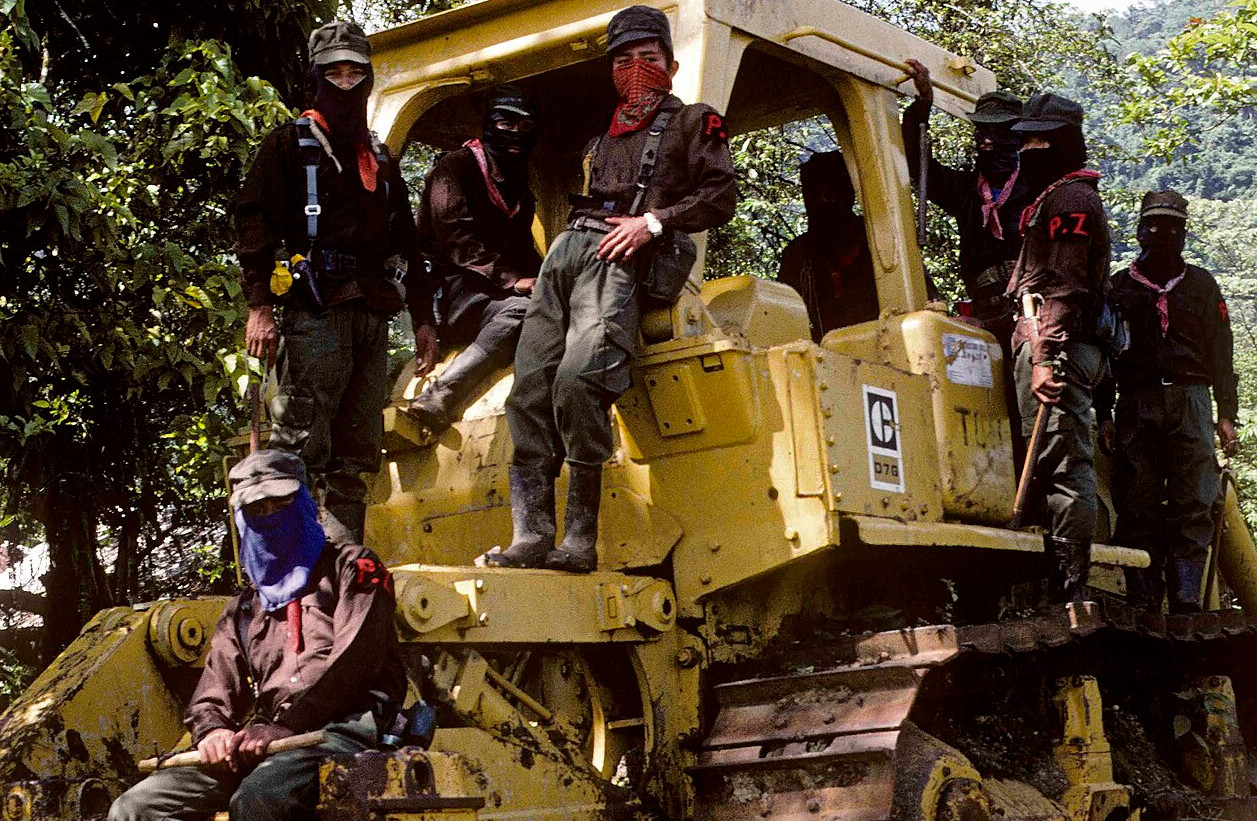
Chiapas and Rojava: Similarities
There are a number of similarities between the Anarchist-inclined revolutionaries of indigenous Mexico and northern Syria:
- Semi-Nationalism: There is a nationalist (Kurdish) or ethnic (Mexican indigenous) aspect to these communities. This is reminiscent of Anarchists in the Spanish Civil War, who were centered in Barcelona, the heart and hub of Catalan nationalism.
- Former Marxists: The Kurdish Anarchist communities are deeply influenced by the PKK (The Kurdish Workers Party), a fundamentally Marxist organization, although this group's influence has been waning in comparison to the Libertarian municipalities of Rojava. Similarly, Marxism has become thoroughly traditional for all modern, Latin American revolutionaries, including the Zapatistas, who are influenced by humanistic Marxists like Antonio Gramsci and Paulo Freire.
- Feminists: The Kurdish Anarchists have made woman and Feminism the absolute center of their Anarchist Revolution. And the Zapatistas are similarly Feminist, with equal rights for women in all spheres of life, with many women in high, officer positions in the armed forces. EZLN speakers often use the friendly phrase companeroa (a gender-neutral version of comanpero/companera) to refer to those who identify with a non-binary gender.
- Ecology: Both groups focus heavily in support of ecological restoration and protection of the environment.